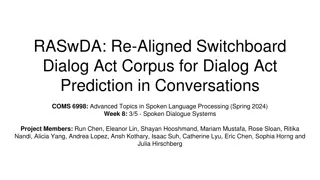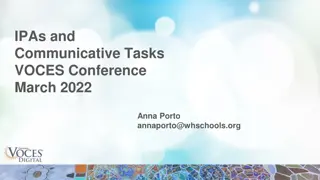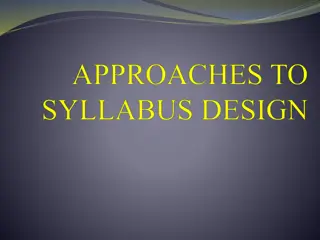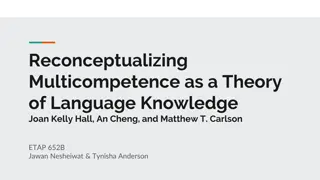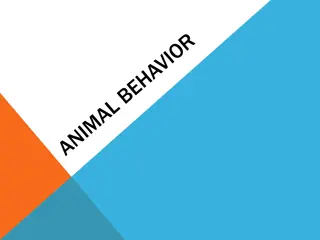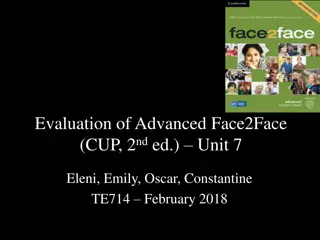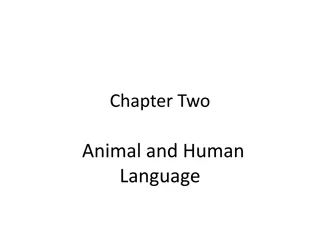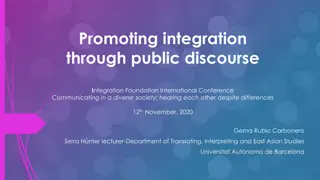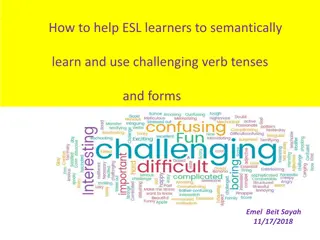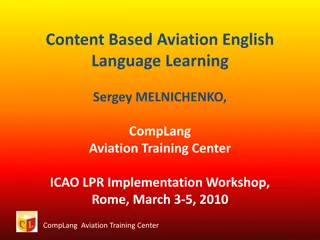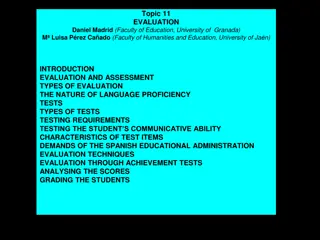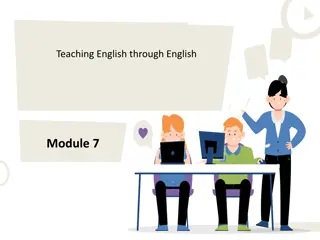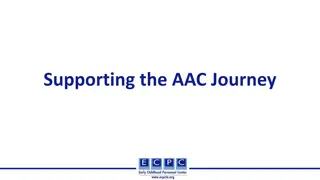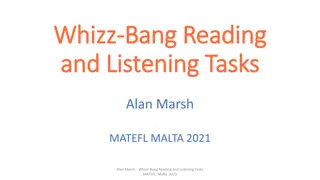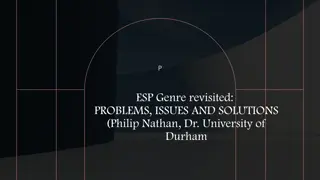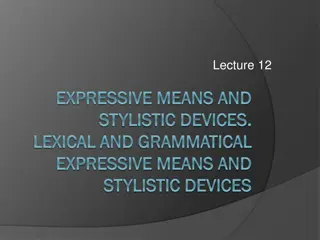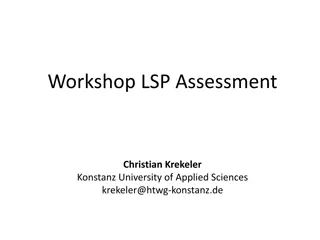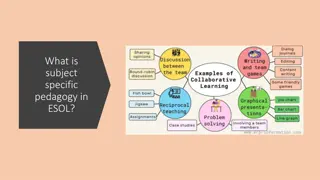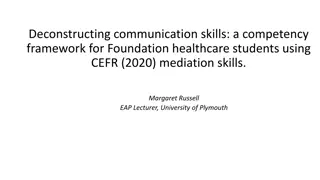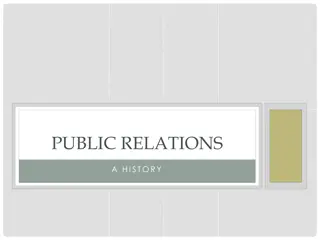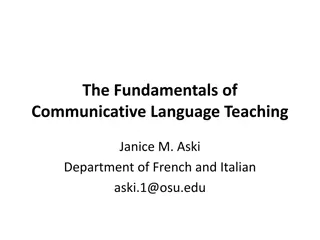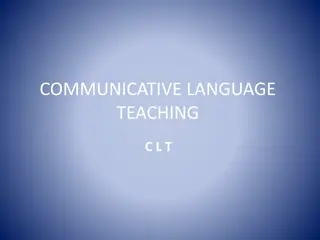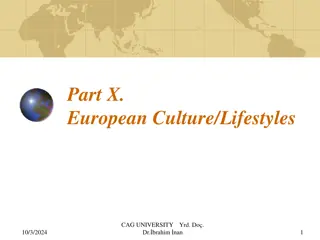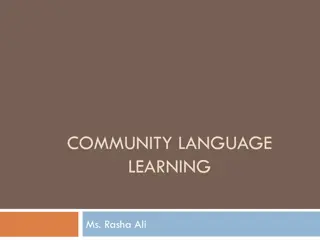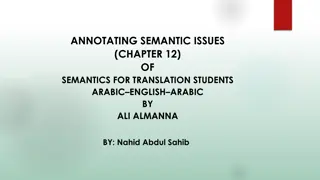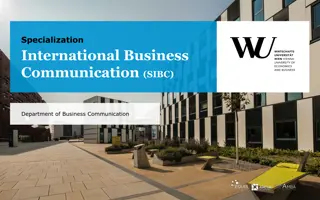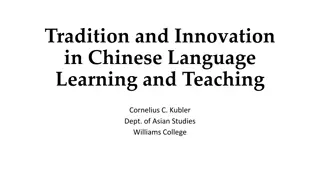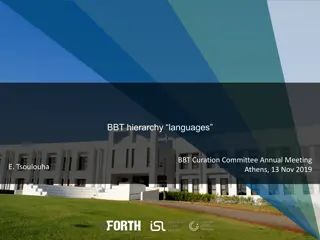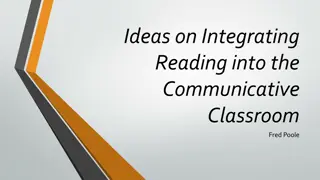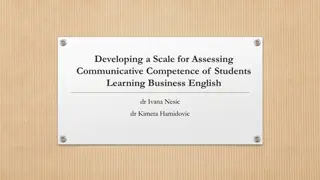English Language Teaching MODULE III
The different methods of language teaching, including Grammar Translation, Direct, Audio-Lingual, Audio-Visual, and Communicative approaches. Learn about their characteristics, advantages, and disadvantages.
3 views • 33 slides
Community Language Learning
Community Language Learning (CLL) involves collaborative language learning where teachers act as counselors and learners work together. CLL teachers aim to teach communicative language skills, foster self-learning, and mutual learning among students through valuing thoughts and feelings. Popular
3 views • 14 slides
Dialog Acts in Spoken Language Processing
Dialog acts encompass the communicative function and semantic content in conversations, influencing cognitive states and context. They have multiple realizations and interpretations, impacting dialog systems' language generation and recognition processes. Dialog acts play a crucial role in spoken di
0 views • 16 slides
Exploring the Role of Novels in Teaching English Proficiency
Utilizing novels in English language teaching offers authentic and engaging cultural material, enhancing linguistic and communicative skills development. The shift towards cognitive methodologies has highlighted the significance of literature in creating meaningful learning contexts. Despite challen
2 views • 40 slides
Enhancing Language Proficiency Through IPAs and Communicative Tasks
Explore the integration of Integrated Performance Assessments (IPAs) and Communicative Tasks in language teaching, focusing on building student proficiency in reading, listening, speaking, and writing. Discover practical tips for implementing and managing IPAs, along with engaging communicative task
1 views • 16 slides
Language Teaching Syllabus: Integration, Theory, and Approaches
Language Teaching Syllabus involves the integration of subject matter and linguistic elements, guided by theories of language and learning. Various approaches like Grammatical, Situational, Communicative, and Analytic are used to structure syllabi. Breaking language into parts aids in sequential lea
1 views • 28 slides
Multicompetence Theory in Language Knowledge
Multicompetence theory, as proposed by Vivian Cook, describes a unique state of language knowledge where bilinguals exhibit enhanced cognitive abilities compared to monolinguals. Evidence shows bilinguals excel in tasks requiring linguistic analysis, divergent thinking, metalinguistic awareness, and
2 views • 13 slides
Animal Behavior: Instincts, Learning, and Social Interactions
Explore the intricate world of animal behavior, delving into instinctual reflexes at birth, learning processes such as habituation and conditioning, and the diverse types of behaviors animals exhibit, from sexual and maternal instincts to communicative and social interactions. Gain insights into how
0 views • 14 slides
Evaluation of Advanced Face2Face (CUP, 2nd ed.): Unit 7 Findings and Conclusions
Evaluation of Unit 7 in the Advanced Face2Face coursebook involves assessing various aspects such as design, content, practice, and methodology using impressionistic criteria. Teachers Eleni, Emily, Oscar, and Constantine individually evaluated the unit based on their impressions. The evaluation hig
0 views • 9 slides
Uniqueness of Human Language and Communication Contrasted with Animal Communication
Human language possesses unique properties such as reflexivity, displacement, and arbitrariness, setting it apart from animal communication. These distinctions enable humans to communicate abstract concepts, discuss past and future events, and use arbitrary linguistic forms. The contrast between hum
1 views • 17 slides
Promoting Integration Through Public Discourse: International Conference Insights
Public discourse plays a crucial role in shaping societal perceptions of diversity and integration. The Integration Foundation International Conference delved into communicative practices that both promote and hinder integration, emphasizing the responsibility of public communicators in constructing
6 views • 15 slides
Engaging Activities for ESL Learners to Master Challenging Verb Tenses
Enhance ESL learners' understanding and usage of difficult verb tenses through contextualized rules, interactive involvement, and fun communicative games. Explore challenging forms like past perfect vs. simple past and passive voice with practical examples and engaging activities.
0 views • 22 slides
Content-Based Aviation English Language Learning Overview
Explore the significance of content-based learning in aviation English language training. Delve into scenarios such as the Avro 685 Crash Landing, Midair Collisions, and communication challenges faced in radio telephony exchanges. Understand the importance of well-formed communicative competence and
1 views • 19 slides
Developing Communicative Competence in English Language Teaching
In English language teaching, the main goal of a communicative classroom is to foster students' communicative competence. This includes grammatical competency, sociocultural competency, discourse competency, and strategic competency. By focusing on these aspects, educators aim to enhance students' a
0 views • 7 slides
Interactive Design Workshop: Pine Tree Creation Using Design Thinking
Join us in an engaging design workshop where you will learn the principles of Design Thinking by drawing a pine tree on a Cartesian plane. Through activities like warming up, empathizing, ideating, defining, and prototyping, you will enhance your collaborative problem-solving skills while creating i
0 views • 14 slides
Evaluation and Assessment Techniques in Language Proficiency Testing
Evaluation and assessment in language proficiency testing involve systematic data gathering to assess students' communicative abilities. Different types of evaluation, such as formative and summative, are discussed along with techniques like observation, analysis of work, and creating situations to
0 views • 41 slides
Ethical Considerations in Organ Donation for Neurologically-Aware Patients
This information highlights the process of honoring the desire of neurologically-aware patients to donate organs after circulatory death. It discusses the referral, legal authorization, triggers for consideration, and ethical aspects involved in approaching and discussing organ donation with the pat
0 views • 15 slides
Teaching English: Adapting Materials for Effective Communication
Explore ways to analyze and adapt textbook lessons for meaningful use in English language teaching. Learn how to enhance classroom interactions by utilizing various teaching resources to develop engaging communicative activities suited for diverse learning environments.
0 views • 10 slides
Supporting the AAC Journey: A Specialist's Perspective
Although conventional communication may not be present, recognizing different signals is crucial in shaping functional communicative behaviors. Specialists play a vital role in enhancing language potential through AAC, impacting future language development. Using aided language modeling and fosterin
0 views • 7 slides
Effective Reading and Listening Strategies in Language Teaching
Explore the various purposes and tasks involved in communicative language teaching, focusing on reading and listening skills development. Understand the importance of activating schemata, developing reading strategies, and language production activities such as speaking and writing. Delve into diffe
0 views • 39 slides
Revisiting PESP Genre: Problems, Issues, and Solutions
This discussion revisits the problems and issues associated with communicative purpose and social purpose in ESP/Swalesian genre analysis. It delves into the definition and differentiation of communicative purpose (CP) and social purpose (SP), offering insights into their roles in text classificatio
0 views • 20 slides
Lexical and Grammatical Expressive Means in Stylistic Devices
The lecture discusses various lexical and grammatical expressive means in stylistic devices, such as metaphor, personification, allusion, metonymy, synecdoche, irony, epithet, and oxymoron. These tools allow for creative and vivid expressions in language by playing with different meanings and associ
0 views • 22 slides
Task-Based Language Assessment: Adapting LSP Tasks for Assessment Purposes
Explore the integration of Task-Based Language Assessment (TBLA) with Language for Specific Purposes (LSP) tasks to enhance assessment purposes in educational settings. Discover the complexity, authenticity, and cognitive demands of adapting tasks, aiming for communicative outcomes in a real-world c
0 views • 24 slides
ESOL Pedagogy: Subject-Specific Approaches and Principles
ESOL pedagogy involves subject-specific pedagogy, pedagogical knowledge, content knowledge, and sequencing the curriculum. It focuses on making learning topics comprehensible, utilizing students' understandings, and promoting learner autonomy. The underlying principles include activating prior learn
0 views • 11 slides
Communicative Acts on Social Networking Sites
Exploring the taxonomy of communicative acts on social networking sites, this work delves into the impact of design features that influence speech acts, commitment, and normative pressures online. By analyzing common families of communicative acts on SNSs, the research sheds light on how these platf
0 views • 29 slides
Mastering the Art of Good Translation: Key Principles and Techniques
Understanding the essence of translation, its characteristics, and the methods to ensure an accurate conveyance of meaning. Exploring different types of translation and emphasizing the importance of naturalness, clarity, and accuracy in the translation process. Utilizing semantic and communicative s
0 views • 31 slides
Enhancing Communication Skills in Healthcare Education Through Mediation Framework
Utilizing the CEFR Mediation skills framework, this study explores the benefits of incorporating mediation skills in healthcare communication for Foundation stage university students. The integration of mediation descriptors helps create a competency framework that focuses on adaptability, intercult
0 views • 20 slides
Learner Styles and Strategies
Learner styles and strategies play a crucial role in education. There are two main types of learners - Analytic Learners who focus on details first, and Holistic Learners who prefer understanding the whole concept. Analytical learners excel at recalling facts, excel in math and science, and are good
1 views • 37 slides
Evolution of Public Relations: From Stonewalling to Modern Approach
The history of public relations traces back to the 19th century when press agents acted as barriers between companies and media. Initially unpopular, PR evolved during the 20th century with the pioneering work of Ivy Lee, promoting a transparent and communicative approach for companies. The shift fr
0 views • 35 slides
Communicative Language Teaching Fundamentals
Communicative Language Teaching focuses on real-life situations to facilitate meaningful communication. This approach aims to teach language through practical interactions, with a particular lesson goal being to learn how to greet, introduce oneself, and ask about others' names and origins. It empha
0 views • 23 slides
Principles of Communicative Language Teaching (CLT)
Communicative Language Teaching (CLT) emphasizes the importance of enabling students to communicate in the target language effectively in real-life situations. This approach focuses on developing linguistic competence and communicative competence to ensure learners can use the language proficiently.
0 views • 15 slides
Cultural Influences on Communication Context at CAG UNIVERSITY
Explore the significant impact of cultural influences on communication context at CAG UNIVERSITY through various images and descriptions. Understand how cultural rules shape communicative behaviors, leading to effective intercultural communication and avoiding potential misunderstandings. Gain insig
0 views • 62 slides
Effective Community Language Learning Method by Ms. Rasha Ali
Community Language Learning (CLL) method emphasizes understanding students' feelings and creating a supportive environment for language learning. This approach, influenced by the Counseling-Learning approach, focuses on building relationships, reducing anxiety, and promoting effective communication
1 views • 15 slides
Annotating Semantic Issues in Translation for Students
This chapter delves into semantic issues in translation, aiming to assist students in annotating their translations from a semantic viewpoint. It emphasizes using semantic information to aid in translating data accurately while maintaining communicative effectiveness. The story discussed highlights
0 views • 19 slides
Specialization in International Business Communication (SIBC)
Specialization in International Business Communication (SIBC) offered by the Department of Business Communication focuses on the critical role of communication in various business settings, emphasizing skills in language usage, communicative competence, and strategic language application. The progra
1 views • 11 slides
Tradition and Innovation in Chinese Language Learning
Continuous innovation is crucial in Chinese language teaching while preserving the value of traditional methods. Strategies like memorization help students internalize language effectively, leading to improved communicative competence. Utilizing model conversations and drills can enhance vocabulary,
0 views • 29 slides
Exploration of Language Hierarchies in BBT Curation Committee Annual Meeting
Delve into the categorization of languages within the BBT hierarchy, discussing the distinctions between natural and formal languages, potential restructurings of language classification, and considerations for expressing communicative power through different language forms.
0 views • 12 slides
The Study of Language: Understanding Communication in Humans and Animals
Language is described as an arbitrary system of vocal symbols used for communication. Animals communicate through various methods, such as sounds, visual cues, and scents. Human language involves duality, allowing for the combination of sounds to convey meaning. Animals lack the ability to break dow
0 views • 11 slides
Enhancing ESL Learning Through Interactive Reading Strategies
Integrating reading activities in communicative ESL classrooms is crucial for fostering language skills. Reading can be conducted both inside and outside the classroom, with in-class activities like monitoring student reading, assisting students, teaching reading skills, and encouraging pair work. R
0 views • 34 slides
Communicative Competence in Business English Students
Developing a scale for assessing communicative competence in students learning Business English involves understanding the models of communicative competence, the difference between communication and communicative competence, as well as the relationship between language knowledge and language use. T
0 views • 29 slides


